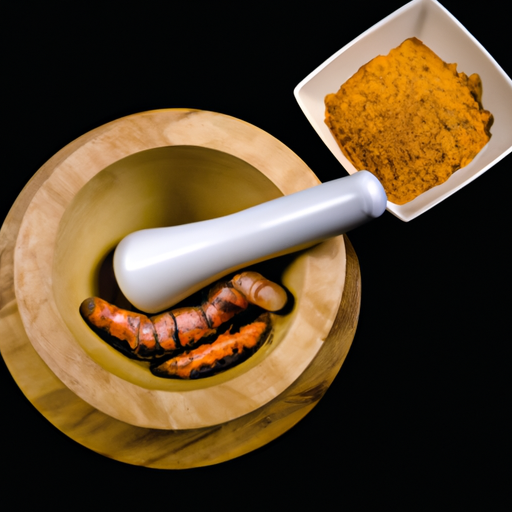Oh, the joys of pain! It’s like an unwelcome guest that just won’t leave. We’ve all been there, desperately searching for a solution to alleviate those nagging aches and pains.
Well, my friends, have you heard about the magical powers of turmeric? Yes, you heard me right – turmeric! This vibrant yellow spice has been hailed as a natural remedy for pain relief, and it’s about time we dive into the nitty-gritty details of how long it actually takes for turmeric to work its wonders.
Now, before we get into the nitty-gritty, let’s understand the properties of turmeric. This ancient spice contains a compound called curcumin, which is believed to have anti-inflammatory and antioxidant properties. These properties are thought to be responsible for turmeric’s potential pain-relieving effects.
But here comes the million-dollar question: how long does it actually take for turmeric to start working its magic? Well, my friends, the answer isn’t as simple as we’d like it to be. The time frame for turmeric to take effect can vary from person to person. It depends on factors such as the dosage, frequency of intake, and individual differences in absorption and metabolism.
So, my fellow pain sufferers, buckle up as we embark on a journey to uncover the truth about turmeric and its pain-relieving powers. Along the way, we’ll explore the absorption and bioavailability of turmeric, dosage and frequency recommendations, potential side effects, and the art of combining turmeric with other natural remedies.
But remember, always consult with a healthcare professional before incorporating turmeric into your pain management routine. Let’s dive in and bid farewell to pain, one golden spoonful at a time!
Key Takeaways
- Turmeric contains curcumin, which has anti-inflammatory and antioxidant properties that can help alleviate pain by reducing inflammation, protecting against oxidative damage, and blocking pain signals.
- The effectiveness of turmeric for pain relief may vary depending on factors such as dosage, frequency of intake, individual differences in absorption and metabolism, and whether it is consumed with black pepper or coconut oil to enhance curcumin absorption.
- The timeframe for turmeric to take effect on pain can vary, with some experiencing relief within a few days and others taking a few weeks.
- It is important to take turmeric consistently and at the right dosage (500-2,000 milligrams per day) to maximize its benefits, and to consult with a healthcare professional before starting turmeric or if taking other medications.
Understanding the Properties of Turmeric
You’ll be amazed at the incredible properties of turmeric and how it can help alleviate your pain. Turmeric, also known as Curcuma longa, is a spice that has been used for centuries in traditional medicine. It contains a compound called curcumin, which is responsible for its many health benefits.
One of the key properties of turmeric is its anti-inflammatory effect. Inflammation is a natural response of the body to injury or infection, but chronic inflammation can contribute to pain and disease. Curcumin has been found to inhibit the activity of inflammatory enzymes, reducing inflammation and providing relief from pain.
Turmeric also has antioxidant properties, which help protect the body against damage caused by free radicals. Free radicals are unstable molecules that can cause oxidative stress, leading to inflammation and chronic pain. By neutralizing these free radicals, turmeric can help alleviate pain and promote overall well-being.
In addition to its anti-inflammatory and antioxidant properties, turmeric has been shown to have analgesic effects. This means that it can directly reduce pain by blocking the transmission of pain signals in the body.
Understanding the properties and benefits of turmeric is just the first step in harnessing its potential for pain relief. The next section will delve into the absorption and bioavailability of turmeric, which are key factors in determining how long it takes for turmeric to work for pain relief.
Absorption and Bioavailability of Turmeric
When it comes to the absorption and bioavailability of turmeric, two key points to consider are the importance of curcumin and the role of black pepper in enhancing absorption.
Curcumin, the active compound in turmeric, is known for its powerful anti-inflammatory and antioxidant properties, making it crucial for its therapeutic effects. However, curcumin has low bioavailability, meaning that it is poorly absorbed by the body.
Thankfully, black pepper contains a compound called piperine, which has been shown to significantly enhance the absorption of curcumin, making it a valuable addition to any turmeric supplement or recipe.
Importance of curcumin
If you want to experience the full power of turmeric’s pain-relieving properties, let curcumin be the hero that fights off your discomfort. Curcumin, the active compound found in turmeric, holds great importance in reducing inflammation and promoting joint health. Here are three reasons why curcumin is essential in harnessing the benefits of turmeric:
-
Enhanced Inflammation Relief: Curcumin has been shown to inhibit the activity of inflammatory enzymes, reducing the production of inflammatory molecules in the body.
-
Joint Support: Curcumin has been found to have a positive impact on joint health by reducing pain, stiffness, and swelling.
-
Antioxidant Power: Curcumin possesses strong antioxidant properties, which help protect the body against oxidative damage and promote overall well-being.
By understanding the importance of curcumin, you can unlock the full potential of turmeric for pain relief. Transitioning into the next section about enhancing absorption with black pepper, we can further optimize the benefits of turmeric.
Enhancing absorption with black pepper
To fully maximize the benefits of turmeric, your taste buds will dance with delight as black pepper joins the party, enhancing the absorption of curcumin and allowing its healing powers to flow freely through your body. While black pepper is a common and effective enhancer, there are also other alternatives that can be used to boost the absorption of curcumin. One such alternative is turmeric and coconut oil, which has been found to increase the bioavailability of curcumin.
When consumed together, turmeric and coconut oil can help to improve the absorption of curcumin, ensuring that you get the most out of this powerful spice. Now that we understand how to enhance the absorption of curcumin, let’s delve into the timeframe for turmeric to take effect and provide relief for pain.
Timeframe for Turmeric to Take Effect
Imagine you’re planting a seed in a garden, and just like that seed needs time to grow into a beautiful flower, turmeric also takes time to work its magic on your pain.
When it comes to the timeframe for turmeric to take effect on pain, it’s important to understand that it varies from person to person. Some individuals may experience relief within a few days, while for others, it may take a few weeks. The effectiveness of turmeric in relieving pain is backed by scientific research.
Curcumin, the active compound in turmeric, has been found to have anti-inflammatory and analgesic properties that can help alleviate pain. However, it’s worth noting that the results may not be immediate and consistent for everyone.
To maximize the benefits of turmeric, it is recommended to take it consistently and at the right dosage. Additionally, combining turmeric with black pepper, as mentioned in the previous subtopic, can enhance its absorption and potentially speed up the effectiveness. However, it’s important to consult with a healthcare professional for personalized dosage and frequency recommendations.
Transitioning into the subsequent section about dosage and frequency recommendations, it is crucial to find the right balance to reap the full benefits of turmeric in managing pain.
Dosage and Frequency Recommendations
When it comes to getting the most out of turmeric for pain management, finding the right dosage and frequency is crucial. Turmeric can be taken in various forms, such as capsules, powder, or as an ingredient in food. The recommended dosage of turmeric for pain relief varies depending on the individual and the severity of the pain.
However, a typical dosage range is 500-2,000 milligrams of turmeric per day. It is important to note that curcumin, the active compound in turmeric, has low bioavailability, meaning that it’s poorly absorbed by the body. To enhance absorption, it’s often recommended to take turmeric with a meal that contains healthy fats or to choose a supplement that includes black pepper extract, which has been shown to increase curcumin absorption.
Additionally, it’s advisable to start with a lower dose and gradually increase it, as some individuals may experience stomach upset or other digestive issues at higher doses. Lastly, it’s important to consult with a healthcare professional before starting any new supplement, especially if you’re taking other medications, as turmeric may interact with certain drugs.
Moving forward, it’s essential to consider potential side effects and precautions when using turmeric for pain management.
Potential Side Effects and Precautions
After discussing the recommended dosage and frequency of turmeric for pain relief, it’s important to also consider the potential side effects and precautions associated with its use.
While turmeric is generally considered safe for most people when taken in appropriate doses, it can cause certain side effects in some individuals. These may include stomach upset, nausea, dizziness, or diarrhea. It’s also important to note that turmeric may interact with certain medications, such as blood thinners, and could increase the risk of bleeding. Therefore, it’s advisable to consult with a healthcare professional before starting turmeric supplementation, especially if you have any underlying medical conditions or are taking any medications.
In addition to potential side effects, there are also some precautions to keep in mind when using turmeric. Pregnant and breastfeeding women are generally advised to avoid high doses of turmeric, as its effects on the fetus or infant are not well-established. Individuals with gallbladder problems or bile duct obstruction should also exercise caution, as turmeric may exacerbate these conditions.
Considering the potential side effects and precautions associated with turmeric, it’s important to be informed and make an educated decision regarding its use.
Now, let’s explore how turmeric can be combined with other natural remedies to enhance its pain-relieving effects.
Combining Turmeric with Other Natural Remedies
When it comes to natural remedies, I’ve found that combining turmeric with other ingredients can enhance its effects. One such ingredient is ginger, which has anti-inflammatory properties that can complement turmeric’s pain-relieving benefits.
Additionally, I’ve discovered that making turmeric tea or golden milk recipes can be a delicious way to incorporate turmeric into my daily routine while reaping its numerous health benefits.
Ginger for enhanced effects
Additionally, combining ginger with turmeric can amplify their pain-relieving effects. Ginger, like turmeric, is a natural anti-inflammatory and analgesic agent. It contains compounds called gingerols, which have been shown to reduce pain and inflammation in the body. When ginger is combined with turmeric, these two powerful ingredients work synergistically to provide even greater relief from pain.
Not only does ginger enhance the effects of turmeric, but it also offers its own health benefits. Ginger has been used for centuries to soothe digestive issues, reduce nausea, and boost the immune system. It can be consumed in various forms, such as ginger tea, ginger ale, or added to recipes for a spicy kick.
Transitioning into the subsequent section about turmeric tea and golden milk recipes, incorporating ginger into these recipes can further enhance their pain-relieving properties.
Turmeric tea and golden milk recipes
To enhance the pain-relieving properties of turmeric tea and golden milk, you can easily incorporate ginger, adding a spicy kick that takes these recipes to a whole new level. Not only does ginger add flavor, but it also has its own anti-inflammatory and analgesic properties that complement the benefits of turmeric. One way to incorporate ginger is by adding a few slices of fresh ginger root to your turmeric tea or golden milk recipe. Alternatively, you can use powdered ginger for a more convenient option. Below is a table that provides two different recipes, a turmeric latte and a turmeric smoothie, both of which can be enhanced with ginger. Remember, it’s always a good idea to consult with a healthcare professional before making any significant changes to your diet or supplement routine.
Consultation with a Healthcare Professional
If you’re experiencing pain and want to know how long it takes for turmeric to work, consulting with a healthcare professional can provide you with personalized guidance and ensure your safety.
While turmeric has been used for centuries in traditional medicine for its potential anti-inflammatory properties, it’s important to remember that it may not be a suitable alternative pain relief option for everyone.
When consulting with a healthcare professional, they can evaluate your specific condition and provide you with evidence-based recommendations. They may discuss the potential benefits of turmeric and its active compound, curcumin, in managing pain. They can also assess any potential interactions with other medications you may be taking and guide you on the appropriate dosage and form of turmeric to use.
Additionally, a healthcare professional can help you explore other herbal remedies and alternative pain relief options that may complement or be more appropriate for your specific condition. They can provide you with a comprehensive treatment plan that takes into consideration your overall health and any underlying medical conditions.
Remember, always consult with a healthcare professional before starting any new treatment or incorporating herbal remedies into your pain management routine. They have the expertise to provide personalized guidance and ensure your safety.
Frequently Asked Questions
Can turmeric be used for pain relief in specific conditions such as arthritis or migraines?
Turmeric has potential for pain relief in conditions like arthritis and migraines. Studies suggest it may alleviate menstrual cramps and fibromyalgia pain. However, more research is needed to determine its effectiveness and optimal dosage.
Are there any known drug interactions with turmeric that I should be aware of?
There are potential drug interactions between turmeric and blood thinners or anti-inflammatory drugs. It is important to consult with a healthcare professional before using turmeric alongside these medications to avoid any adverse effects.
Can turmeric be used topically for localized pain relief?
Turmeric can be used topically as a natural alternative for localized pain relief. It is important to be aware of potential side effects such as skin irritation or allergic reactions.
How long does the pain-relieving effect of turmeric last?
The pain-relieving effect of turmeric can vary in duration depending on various factors such as the severity of the pain, dosage, and individual response. Long-term effectiveness may require consistent and prolonged use.
Are there any specific recommendations for turmeric usage for children or pregnant women?
There are limited studies on turmeric usage for children and pregnant women. It is important to consult with a healthcare provider for specific recommendations due to potential risks and benefits associated with turmeric in these populations.
Conclusion
In conclusion, it’s important to note that turmeric can be a helpful natural remedy for pain relief. However, the timeframe for turmeric to take effect can vary depending on factors such as absorption, bioavailability, dosage, and frequency. It’s recommended to consult with a healthcare professional to determine the appropriate dosage and to ensure that there are no potential side effects or interactions with other medications.
Remember, "patience is a virtue," and with consistent use and guidance, turmeric may provide relief from pain in due time.










